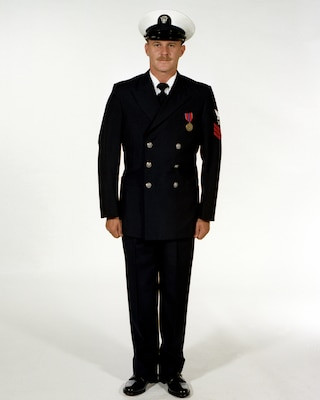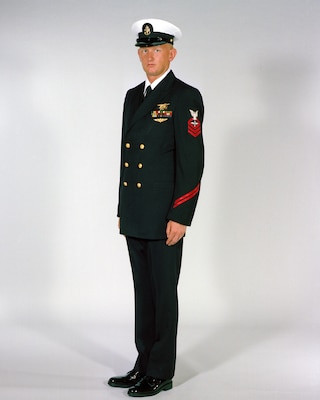The early 1970s marked a pivotal era for the United States Navy, coinciding with President Nixon’s announcement to transition to an all-volunteer military force amidst the ongoing Vietnam War. While the Navy itself wasn’t drafting personnel, a significant portion of enlistees, estimated to be around one-third, were motivated by draft avoidance. To attract and retain personnel in this new all-volunteer environment, the Navy needed to enhance its appeal, leading to a wave of reforms and incentives. Among these, the traditional “crackerjacks” uniform, with its distinctive 13-button “bell bottoms” worn by enlisted Sailors up to grade E-6, became a subject of intense scrutiny and eventual change.
For years, the “bells” uniform had been debated, but the push for modernization gained momentum. A Navy-wide survey in late 1970 revealed that a staggering 80 percent of enlisted Sailors favored uniform modifications. Junior officers echoed this sentiment, largely supporting a more officer-style uniform across the board. Interestingly, the survey also highlighted that 92 percent of officers and chief petty officers (CPOs) were content with their service dress blues, creating a clear divide in uniform satisfaction within the ranks.
Master Chief Petty Officer of the Navy (MCPON) John “Jack” D. Whittet became a vocal advocate for change. He conveyed to Chief of Naval Operations (CNO) Adm. Elmo R. Zumwalt Jr. the growing sentiment among Sailors that the “bells” uniform felt emasculating. This internal pressure was amplified by external factors. Spouses voiced their embarrassment at seeing their husbands in “crackerjacks” in civilian settings, desiring a more mature and respectable appearance for their Navy partners. Furthermore, rising anti-military sentiment in the country made Sailors in their distinctive uniforms targets for ridicule and negativity.
These converging pressures culminated in a significant announcement. On June 13, 1971, Admiral Zumwalt issued Z-Gram 87, a directive that would fundamentally alter Navy uniforms. This Z-Gram informed the Fleet of an impending uniform overhaul, aiming to standardize uniforms for all personnel, from recruits to admirals. The new service dress blues were slated for issue to recruits starting July 1, 1973, with a mandatory adoption date for all Sailors by July 1, 1975. This included both winter and summer weight versions. The announcement also signaled the phasing out of the khaki service dress uniform for officers and CPOs and the service dress white uniform for CPOs, all effective on the same date.
The redesign of the service dress blues placed significant emphasis on distinguishing rank through details like buttons and hat insignia. Lower enlisted grades (E-1 through E-6) would wear silver buttons, while officers and CPOs would retain gold buttons. Headwear for lower enlisted ranks remained the combination cap, also known as the “hard hat,” but with a new silver hat insignia featuring an eagle and the letters “USN,” along with silver chin strap buttons for E-6 and below. Crucially, rating insignia, chevrons, and service hash marks remained unchanged, positioned on the left sleeve of the coat, mirroring their placement on the traditional jumper.
Zumwalt articulated that these uniform changes were intended to “bring the Navy into line with its sister services by providing one uniform from seaman to admiral,” emphasizing unity and common purpose. The sweeping changes of Z-Gram 87 even garnered attention from major national newspapers. The New York Times covered the directive on June 15, 1971, with the headline “Navy to Scuttle Old Sailor Suit.” Acknowledging the anticipated mixed reactions, the paper followed up with another article on July 25, titled “Sailors Unhappy about Shedding Bell-Bottoms; Officers Want to Keep Their Uniforms Distinctive,” highlighting the brewing debate within the Navy ranks.
 The service dress uniform worn by enlisted Sailors in the grades of E-1 through E-6. The change was authorized by Z-Gram 87.
The service dress uniform worn by enlisted Sailors in the grades of E-1 through E-6. The change was authorized by Z-Gram 87.
The uniform changes ushered in by Z-Gram 87 became known as the “salt and pepper” uniform, characterized by white shirts worn with navy blue trousers or skirts. This marked the beginning of a turbulent decade for Navy uniform regulations. Even the dungaree working uniform underwent transformation, shifting from traditional denim to a 50-50 cotton-nylon blend. The new working uniform featured a light blue, two-pocket, front-buttoning shirt and dark blue trousers with straight legs and pressed creases. This redesign aimed to make the working uniform more presentable for wear in public areas on base and during commutes. However, the synthetic blend proved problematic for shipboard use due to its flammable nature. More broadly, the high synthetic content across the new uniform items led to complaints regarding fit and comfort.
In the broader context of making the Navy more appealing, Zumwalt issued a series of Z-grams addressing various aspects of Sailor life. Z-Gram 70, for example, tackled grooming standards in response to the growing civilian trend of long hair and beards in the late 1960s and early 1970s. While fully adopting civilian long hairstyles remained off-limits, Z-Gram 70 relaxed haircut standards and formally acknowledged the existing regulation allowing beards, stipulating that facial hair should be “well groomed and neatly trimmed.” Despite the existing regulation, many commanding officers had previously disallowed beards, and Zumwalt’s stance faced criticism from his predecessors, who he humorously countered by referencing historical portraits of bearded naval officers.
 Men’s service dress blue uniform, chief petty officers, 1984. Note the gold buttons that distinguish the CPO from lower-grade enlisted Sailors, who wore silver buttons.
Men’s service dress blue uniform, chief petty officers, 1984. Note the gold buttons that distinguish the CPO from lower-grade enlisted Sailors, who wore silver buttons.
Despite the efforts to improve Sailor morale and adapt to changing social norms, some individuals misused the relaxed regulations. In an August 1971 interview with All Hands magazine, MCPON Whittet expressed disappointment in “a few thoughtless individuals” who were “abusing the trust and respect given them.” He noted complaints about Sailors improperly wearing the dungaree working uniform as a liberty uniform, highlighting a tension between newfound freedoms and traditional standards.
Resistance to Zumwalt’s reforms, particularly the uniform changes, was prevalent among “old salts” and senior personnel throughout the Navy. However, a poll conducted in spring 1971 indicated that 86 percent of enlisted personnel and 80 percent of officers actually approved of the new policies overall. The discontent was concentrated among senior enlisted and officer ranks, who primarily opposed the rapid pace and volume of changes rather than the changes themselves. The sheer influx of Z-grams overwhelmed commanding officers and senior petty officers, straining the traditional chain of command. A perception emerged that Z-grams directly addressed Sailors, bypassing established leadership structures. Commanding officers, accustomed to set procedures, felt undermined by the CNO’s direct interventions. Senior petty officers found themselves navigating conflicting pressures from junior personnel eager to embrace the new freedoms and officers intent on upholding discipline. Zumwalt defended his initiatives as an effort to foster respect for individual dignity and worth at all levels of the Navy.
When Admiral Zumwalt concluded his tenure as CNO on July 1, 1974, he rescinded all 121 of his Z-grams, hoping their principles would endure. While many of his broader policy changes, such as improved opportunities for minorities and women, did have lasting impact, the enlisted dress uniform change brought about by Z-Gram 87 proved to be relatively short-lived. In 1986, responding to a wave of nostalgia and a push to restore naval tradition, the bell bottom 13-button trousers and the “crackerjack” uniform made a comeback. This reversal underscored the enduring appeal of naval heritage and the cyclical nature of uniform evolution, even as other advancements, like safer and more practical working uniforms, continued to shape the modern U.S. Navy.

